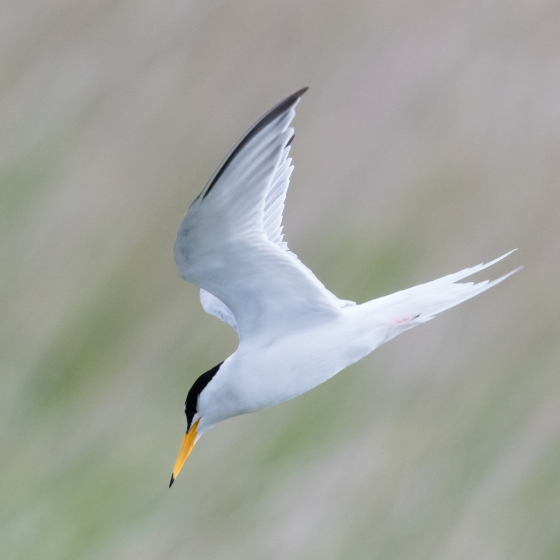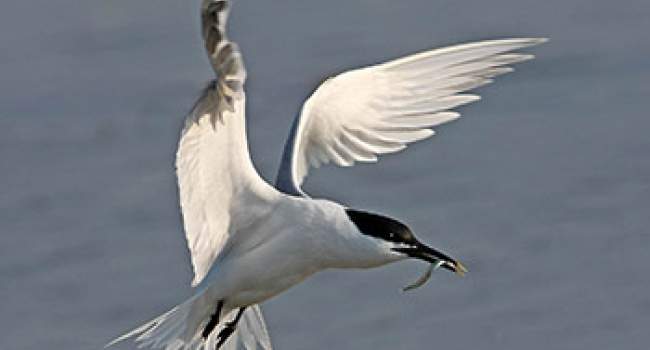Little Tern
Sternula albifrons (Pallas, 1764)
AF
 LITTE
LITTE  6240
6240

Family: Charadriiformes > Laridae

Little Tern is a summer visitor to our shores, arriving in April to coastal breeding colonies. This small tern favours sand or shingle for nesting, and nests at lower densities than our other breeding tern species.
Elsewhere in its wider breeding range the Little Tern occupies both coastal and inland sites; British and Irish birds are almost entirely coastal in habits, its colonies sometimes threatened by the presence of visiting Foxes or the disturbance caused by human activities.
Wardening of Little Tern breeding colonies is a key conservation tool, with efforts directed towards larger colonies in areas of human activity.
Identification
Little Tern identification is usually straightforward. The following article may help when identifying Little Tern.
SONGS AND CALLS
Listen to example recordings of the main vocalisations of Little Tern, provided by xeno-canto contributors.
Call
Song
Develop your bird ID skills with our training courses
Our interactive online courses are a great way to develop your bird identification skills, whether you're new to the hobby or a competent birder looking to hone your abilities.
Browse training coursesStatus and Trends
Population size and trends and patterns of distribution based on BTO surveys and atlases with data collected by BTO volunteers.
CONSERVATION STATUS
This species can be found on the following statutory and conservation listings and schedules.
POPULATION CHANGE
The Little Tern is monitored by Seabird Monitoring Programme (JNCC 2022 or link to wesbite) and the Rare Breeding Birds Panel. The Atlas maps show range losses since 1968–72 (Balmer et al. 2013). The population fluctuated between 1969 and 1975 when numbers peaked at 2,800 pairs, but subsequently declined (Ratcliffe et al. 2000), with a mean of 1,375 breeding pairs counted over the five-year period 2015–2019 (Eaton et al. 2021). However, numbers have been stable over the 15 years to 2019 (Eaton et al. 2021)
| UK winter population |
-9% decrease (1995/96 to 2020/21)  |
DISTRIBUTION
Little Terns nest mostly on beaches on mainland Britain & Ireland. In Britain, c.75% of the population breeds in England, the majority on three sections of coast: the Humber/Lincolnshire, East Anglia and the Solent.
More from the Atlas Mapstore.
Occupied 10-km squares in UK
| No. occupied in breeding season | 102 |
| % occupied in breeding season | 3.4 |
European Distribution Map
DISTRIBUTION CHANGE
The breeding range change map principally captures a picture of colony loss, particularly from the Thames Estuary and Kent, Anglesey, the Solway, the outer parts of the Firths of Forth and Tay, and throughout the Irish coast. The most significant gains since the 1988–91 Breeding Atlas have been the cluster of new colonies in northeast England and northeast Scotland.
| % change in range in breeding season (1968–72 to 2008–11) | -30.9% |
SEASONALITY
Little Terns are localised summer visitors from April/May onwards, departing in August and September.

Movement
Information about movement and migration based on online bird portals (e.g. BirdTrack), Ringing schemes and tracking studies.
RINGING RECOVERIES
View a summary of recoveries in the Online Ringing Report.
Foreign locations of birds ringed or recovered in Britain & Ireland

Biology
Lifecycle and body size information about Little Tern, including statistics on nesting, eggs and lifespan based on BTO ringing and nest recording data.
SURVIVAL & LONGEVITY
View number ringed each year in the Online Ringing Report
Maximum Age from Ringing 
|
25 years 0 months 8 days (set in 2018) 
|
Typical Lifespan 
|
12 years with breeding typically at 3 year |
Adult Survival 
|
0.899  
|
Juvenile Survival 
|
0.578 (in first year) 
|
CODES & CLASSIFICATION
Ring size 
|
B+ |
Field Codes 
|
2-letter: AF | 5-letter code: LITTE | Euring: 6240 |
For information in another language (where available) click on a linked name
Research
Interpretation and scientific publications about Little Tern from BTO scientists.
CAUSES AND SOLUTIONS
Causes of change
Population decline has been linked to reduced productivity; the main drivers behind this are unclear but disturbance, predation and flooding may have contributed (Ratcliffe et al. 2000). Little Terns nest on beaches which can change substantially from one year to the next and the species can shift colony location in response to predation and habitat change and is also highly susceptible to disturbance (JNCC 2012). Intensive management across major UK colonies, including protection and habitat restoration and creation, has been successful at increasing breeding productivity, but population models suggest that this increase will not be sufficient to reverse population declines and that further solutions are needed (Wilson et al. 2020).
Links to more information from ConservationEvidence.com
Would you like to search for another species?











Share this page